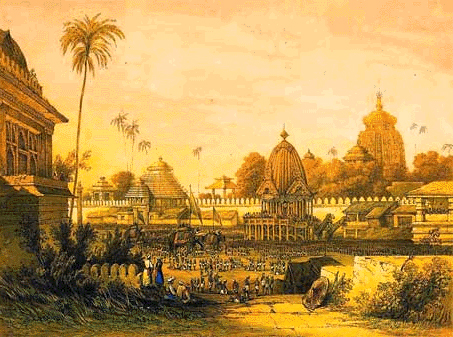
|
|
|
|
BY: SUN STAFF

Jagannatha Puri Jan 04, CANADA (SUN) — An historical study in two parts of the establishment of brahminical communities in Orissa state. Mukti-mandapa of Jagannath Temple - The seat of Utkala Bahmin Authority
The Mukti-mandapa, or the platform for salvation, is situated at the southern side of the Jagannath Temple of Puri. The Govardhan math's Sankaracharya is the permanent President of Mukti-mandapa, and he is therefore entitled to sit on the Mukti-mandapa asana, which is reserved for him alone. Ramachandara Dev, the first king of the Bhoi Dynasty, installed as Raja of Khurda, is said to have renovated the Mukti-mandapa structure with 16 pillars. He recognized 16 brahmin villages – the Shohala Sasan Villages -- and the leader brahmins of those villages area also permitted to sit in the Mukti-mandapa.
The Mukti-mandapa brahmins adjudicate intra-caste and intra-village disputes, and offer prescriptions (byabastha) comprised of purificatory advice (prayaschita bidhi) for those who have committed various social sins. Sub-castes among Utkala Brahmins The Utkala Brahmins are comprised of two classes – the Srotriya and Asrotiya, or Sevaka Brahmins, each of which has its own sub-classes. The Srotriya Brahmins are entitled to read the Vedas, and are therefore known as Vedic brahmins, or Namaskaraniya. They are also known as Danua, Sambhranta, and Kulina brahmins. The sub-classes of Srotriya Brahmins are as follows. a) Dakshinatya Brahmins from regions nearby Puri; and b) Jajpuri Brahmins, who come from the Jajpur area. Brahmins in both these sub-classes are eligible to perform Vedic rites, and they do not intermarry. The Asrotiya Brahmins, also known as Sevaka Brahmins, are divided into four sub-classes, as follows: a) Debalaka (Deulia) Brahmins, who serve the Gods and Goddesses. b) Aranyaka Brahmins, also known as Panchadesi, Jhadua or Jharia Brahmins, who were the first settlers in Sambalpur. They marry among themselves, and other Utkal Brahmin immigrants to Western Orissa and Chhattisgarh refuse to intermarry with them. c) Paniyari (Panda) Brahmins, who are engaged in business and trade of agricultural produce. They also form the priestly class. Some are cooks in temples and even in private houses. They travel all around India, encouraging pilgrims to visit the temples of Lord Jagannath. d) Halua Brahmins, also known as Balaramgotri, who are also engaged in agriculture. They are wealthy businessmen due to their agricultural pursuits, and have entirely lost their sacerdital (priestly) character. In modern times, all members of these castes have made it a practice to take the rice cooked at the Jagannatha Puri temple, eating together without defilement, and enjoying the friendship that develops while taking prasadam together. Festivals of Utakala Brahmins Almost all Sasan villages follow a uniform pattern of religious practices. The main festivals of Orissa's Sasan villages are the Sitala Sasthi, the marriage ceremony of Lord Shiva during May-June, and the Champaka Dwadasi, the marriage ceremony of Lord Gopinatha. Other festivals include Nabanna, Dola Yatra, Jhulan Yatra, Rahasa Yatra, Rath Yatra, Durga Puja, Gamha Purnima, Sudasha Brata, Savitri Brata, Manabasha Gurubar Laxmi Puja, Pousha Purnima, Dwitibahana Osha, Shivaratri, Gajalaxmi Pooja, Prathamastami, Mahalaya/Pitrupakhya, Bijaya Chaturdasi, Ashokastami, Jaulei Panchami, Rekha Panchami, Chitalagi Amabasya, and Deepavali On Gamha Purnima, all the elderly persons congregate and consult on the traditional shares of the family, called pali and Hakara. Resolving these issues is very important to all members of the Sasan villages. Unfortunately, animal sacrifices still go on in many Sasan villages, particularly around the time of Durga Puja. The Shohala Sasan or 'Sixteen Brahmin Villages' around Puri are integrated into the culture of the Jagannath Temple in various ways. On Pushyabhiseka or Debabhiseka day, observed on the full moon day of Pausa (January), representatives of Sasan villages traditionally bless the Gajapati king and worship Lord Jagannath. On Sunia day in Bhadraba (September), the Sasan Brahmins traditionally congregated in the palace of the Gajapati king to celebrate the commencement of the new regnal year. During the sixteen days of Durga Puja, the Sasan Brahmins conduct the worship of Goddess Bimala and other local demigods. On Rukmini Bibaha, the Marriage ceremony of Lord Sri Krishna (Sri Jagannath), the Sasan Brahmins are invited to participate in the festival. On the 7th day of the dark fortnight of Karttika (November), Sola Sasana Bhoga, a grand offering of foodstuffs to Lord Jagannath is held, and all the Brahmins from every Sasan village take part in honoring Mahaprasada. The Oriya Brahmin Surnames The Utkala Brahmins are known by the following surnames: Acharya, Bishi, Chaturvedi, Dash, Dash Sharma, Dikshit (Dixit), Debta (Devta), Gantayat, Kar, Mishra, Mishra, Sharma, Nath, Choudhury, Sahu, Sahoo, Dyansamantray, Panigrahy, Palo, Bhatta Mishra, Guru, Rajguru, Rayguru, Pani, Panigrahi, Mohapatra, Rath, Rath Sharma, Sharma, Satpathy, Pani, Pati, Vedi, Dwivedi, Trivedi, Sarangi, Pattajoshi, Joshi, Panda, Bada Panda, Puja Panda, Nanda, Purohit, Pujari, Pathi, Nepak, Devasharma, Tripathy, Praharaj, Padhi, Udgata, Hota, Otta, Bahinipati, and Sabata.
| |